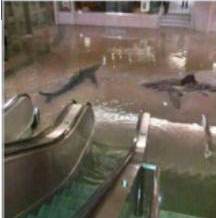Public Resources
Public Resources
SOCIAL MEDIA BEFORE, DURING, & AFTER EMERGENCIES[edit]
Lessons Learned
A. July 2013 - Asiana Airlines Flight 214 Plane Crash
News that Asiana Airlines Flight 214 crashed upon landing at San Francisco International Airport initially broke on Twitter.52 During the first hour after the crash occurred, there were more than 50,000 tweets referencing Asiana, many of which asked for more information, demanded answers, and voiced concern over a lack of communication from the airline.53, 54 However, despite having an established social media presence prior to the crash, Asiana Airlines remained completely silent on social media.55
1. Absence of Social Media Messaging Can Cause Confusion and Frustration
The lack of social media use by Asiana Airlines after the crash caused confusion and distress. The airline consulting firm SimpliFlying “praised federal investigators and San Francisco International Airport for quick statements on the crash and constant social media updates – while crash followers grew increasingly frustrated by the muted response from Asiana.”56[edit]
Frustration with Asiana Airline’s poor communication led the public to turn to other social media outlets and agency websites, such as the National Transportation Security Board and San Francisco International Airport, further tarnishing the reputation of the airline. SimpliFlying stated “Unfortunately, Asiana Airlines, with the world’s eyes set on it, was slow to respond and was far from satisfying the insatiable need for more information in the hours after the crash.”57
 |
The general public expects to find incident information on social media. If no information is posted on the responsible agency’s social media platforms, the public will turn to other sources. Agencies should use social media as one tool to provide updates about an incident directly to the public, reducing mixed messages that lead to confusion and frustration.
2. Delayed Social Media Use Can Lead to Anger
Lack of accessible information from Asiana Airlines contributed to public anger with the airline. Asiana Airlines did not post any information or messages to social media until eight hours after the crash.58 The statement was interpreted as unsympathetic and uninformative, leading the public to become increasingly angry with the company.59
Though the press release was preceded by a tweeted message of thoughtfulness and prayers to those directly impacted by the crash, many individuals did not see it; Asiana Airlines had been so inactive on Facebook and Twitter that individuals had stopped paying attention to the airline’s social media streams. Being active on social media at the onset of an incident is critical to keeping the public informed with accurate information, which will help alleviate stress from the public.
 |
3. Lack of Social Media Communication Can Lead to Distrust
Other than a brief, tweeted apology to families and victims hours after the crash, Asiana Airlines was virtually silent. When the CEO of Asiana Airlines arrived at San Francisco International Airport, he declined to comment. The airline did not have a trained public relations representative to address the media and even instructed passengers not to communicate to anyone via social media.60
The silence equated to distrust in the eyes of the public – it triggered suspicion that the airline was hiding information from the public and was not equipped to handle the crisis.61 When the airline finally posted on Twitter, nearly six hours after the initial crash, many other agencies – including the White House, United Airlines, and San Francisco International Airport – had already Tweeted messages of condolences.62, 63 By not using social media as a tool to communicate with a large audience early in the incident, Asiana Airlines lost the trust of the public as the response continued.
 |
 |
B. October 2012 – Hurricane Sandy
Hurricane Sandy was one of the most destructive storms ever to hit the Eastern seaboard, accounting for over 115 U.S. deaths and millions of dollars in damage.64 Government agencies, particularly in New York and New Jersey, turned to social media before, during, and after Hurricane Sandy to communicate with the public and coordinate with response agencies.65
1. Residents Will Use Social Media To Ask For Emergency Assistance
When people are unable to reach 9-1-1, they turn to social media for assistance.66 The New York City Fire Department (NYFD) tweeted the following: “PLEASE NOTE: *Do not* tweet emergency calls. Please call 911. If it is not an emergency, please call 311. #NYC #Sandy”.67
The repercussion of an inundated emergency dispatch system during an event is that people with true emergencies will not be able to access 9-1-1 or emergency services, and they will likely turn to social media for help. In the case of Hurricane Sandy, the FDNY social media manager, Emily Rahimi, worked throughout the storm, responding to emergency requests coming in through Twitter by taking down information and calling dispatchers to ensure emergency crews were notified. However, many agencies may not be monitoring social media channels and may never receive these requests. Social media should never replace calling 9-1-1 dispatchers in the event of an emergency, but agencies should evaluate their policies for handling emergency messages coming in over social media.
 |
Throughout the storm, doctored photographs flooded the internet, making it difficult for the public to find and verify information. Several images with exaggerated depictions of massive storm clouds and severe flooding went viral on social media,”making it difficult to identify other photos that were


References:
52 Stanglin, D. and Toppo, G. (2013, July 07). Social Media Often First at Tragedy Scene. USA Today. Retrieved from http://www.usatoday.com/story/news/nation/2013/07/07/social-media-asiana-airlines-tweets-david-eun-twitter-tweets/2496903/
53 Hodgson, B. (2013, October 01). Asiana Airlines 214 & Digital Crisis Management- Slide 32. Retrieved from http://www.slideshare.net/Brendan/asiana214-analysisfinal
54 Donnelly, C. (n.d.). Asiana: the (tragic) sound of silence #CrisisPR #SMEM. Retrieved from https://storify.com/columdonnelly/asiana-the-tragic-sound-of-silence-crisispr-smem
55 Nicholas, I. (2013, October 09). Crisis Management Planning 101: Learning from Asiana’s Mistakes. Retrieved from https://www.business2community.com/crisis-management/crisis-management-planning-101-learning-asianas-mistakes-0642189
56 Nakaso, D. (2013, July 16). Asiana Airlines’ perplexing response to Flight 214 crash. San Jose Mercury News. Retrieved from http://www.mercurynews.com/ci_23671823/asiana-airlines-perplexing-response-flight-214-crash
57 Ibid.
58 Nigam, S. Asiana Airlines Crash Crisis Management 2.0 – Case Study and Analysis – Slide 2.
59 Phillips, B. (2013, July 06). Asiana Airlines: An Unsympathetic Press Release. Retrieved from: http://www.mrmediatraining.com/2013/07/06/asiana-airlines-an-unsympathetic-press-release/
60 Kalb, I. (2013, July 22). Asiana Airlines Needs Serious Help With Crisis Management. Marshall School of Business, University of Southern California. Retrieved from http://www.businessinsider.com/asiana-airlines-accident-response-continues-to-be-just-plane-stupid-2013-7
61 Ibid.
62 Nigam, S. (2013, July 09). Asiana Airlines Crash Crisis Management 2.0 – Case Study and Analysis – Slide 2. Retrieved from http://simpliflying.com/2013/asiana-airlines-crash-crisis-management-sfo/
63 Donnelly, C. Asiana: the (tragic) sound of silence #CrisisPR #SMEM.
64 Toro, R. (2013, October 29). Hurricane Sandy’s Impact (Infographics). Retrieved from: http://www.livescience.com/40774-hurricane-sandy-s-impact-infographic.html
65 Virtual Social Media Working Group and DHS First Responders Group. (2013 June). Lessons Learned: Social Media and Hurricane Sandy. Retrieved from: http://www.ghinternational.com/docs/DHS_VSMWG_Lessons_Learned_Social_Media_and_Hurricane_Sandy_Formatted_June_2013_FINAL.pdf
66 Jasper, T. (2013, July 15). Digital Lessons Learned from Super Storm Sandy. Retrieved from https://toddjasper.com/2013/06/24/digital-lessons-learned-from-super-storm-sandy/
67 Fire Department of New York (FNDY) Twitter. (n.d.). Retrieved from: www.twitter.com/FDNY
68 Ibid. Virtual Social Media Working Group and DHS First Responders Group. (2013 June).
69 Ibid. Virtual Social Media Working Group and DHS First Responders Group. (2013 June).

